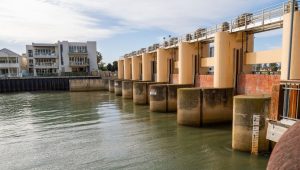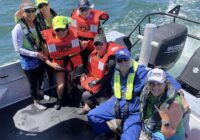Patawalonga gate upgrade in S.A. will help prevent flooding. The $17.3m project, set for completion in 2025, will also ensure a quality marine environment is maintained for recreational activities including boating, fishing and kayaking.

More than $17 million will be spent upgrading the Patawalonga Lake System’s south gates to help mitigate flooding at the airport and around Glenelg.
All eight steel gates, the lifting components and the electronic control system will be replaced under the project, which will also ensure a quality marine environment is maintained for recreational activities including boating, fishing and kayaking.
The new gates will have a lifespan of up to 50 years, and for ongoing functionality of the system, only two gates will be upgraded at a time.
The concrete barrage currently used by pedestrians and cyclists to cross the Patawalonga will be closed to the public for the duration of the project. A temporary walkway will be built on the barrage’s western side for pedestrian access.
There will be some closures of the boat lock during construction, but where possible these will occur outside of peak usage times to minimise disruption to the community.
Manager of Assets and Operations with the Department for Environment and Water Tom Campbell said it was important to upgrade the gates to modern day standards to ensure ongoing safe, effective and reliable operation of the Patawalonga Lake System.
“The gates are opened twice a day on a rising tide, which allows fresh sea water to circulate northward through the lake. This keeps the lake healthy, with the total lake volume replaced with freshwater every 3-4 days,” Mr Campbell said.
“The upgrade will ensure the system remains healthy and can be enjoyed by the community well into the future, as well as help safeguard local infrastructure against the risk of flooding.”
The 1.6km-long Patawalonga Lake System, known locally as “the Pat”, diverts urban stormwater to the sea via the Barcoo Outlet, using the tides to flush the lake with seawater.
McMahon Services Australia has won the contract to deliver the works, which are expected to be complete by mid-2025.
For more information, visit the Department for Environment and Water website







